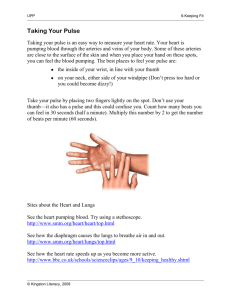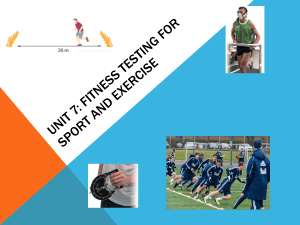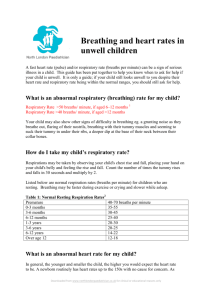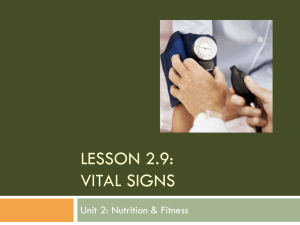Lab #10: Circulatory and Respiratory Systems
advertisement
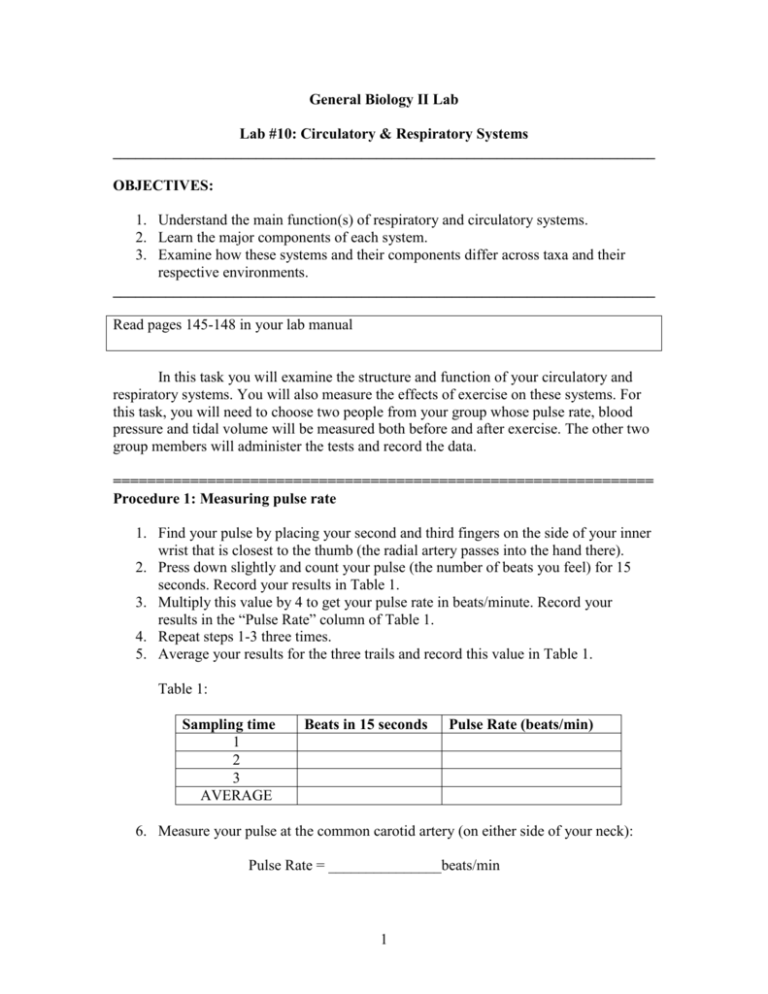
General Biology II Lab Lab #10: Circulatory & Respiratory Systems ________________________________________________________________________ OBJECTIVES: 1. Understand the main function(s) of respiratory and circulatory systems. 2. Learn the major components of each system. 3. Examine how these systems and their components differ across taxa and their respective environments. ________________________________________________________________________ Read pages 145-148 in your lab manual In this task you will examine the structure and function of your circulatory and respiratory systems. You will also measure the effects of exercise on these systems. For this task, you will need to choose two people from your group whose pulse rate, blood pressure and tidal volume will be measured both before and after exercise. The other two group members will administer the tests and record the data. =============================================================== Procedure 1: Measuring pulse rate 1. Find your pulse by placing your second and third fingers on the side of your inner wrist that is closest to the thumb (the radial artery passes into the hand there). 2. Press down slightly and count your pulse (the number of beats you feel) for 15 seconds. Record your results in Table 1. 3. Multiply this value by 4 to get your pulse rate in beats/minute. Record your results in the “Pulse Rate” column of Table 1. 4. Repeat steps 1-3 three times. 5. Average your results for the three trails and record this value in Table 1. Table 1: Sampling time 1 2 3 AVERAGE Beats in 15 seconds Pulse Rate (beats/min) 6. Measure your pulse at the common carotid artery (on either side of your neck): Pulse Rate = _______________beats/min 1 =============================================================== Procedure 2: Measuring the effect of exercise on blood pressure For this procedure, you will work in pairs, serving as subject and experimenter. 1. Attach the inflatable cuff around his/her arm above the elbow (Fig. 6). Tuck the flap of the bag under the fold. Figure 6. Measuring blood pressure 2. Inflate the cuff to about 200 mm Hg. This pressure will collapse the brachial artery, causing the blood flow to stop. At this point, you should not feel a pulse in your partner’s wrist. 3. Place the stethoscope over the brachial artery (underneath the cuff as shown in Figure 6). You should not hear anything with the stethoscope. 4. If the pressure has gone below 200mm Hg, inflate the cuff again. 5. Slowly begin releasing the pressure in the cuff. As the pressure falls, the blood will begin to spurt through the artery, producing vibrations and turbulence that are audible through the stethoscope. You should hear loud, tapping sounds as the heart contracts. The pressure at which you begin hearing these sounds is termed systolic pressure. Systolic pressure =______mm Hg 6. Continue releasing the pressure from the cuff until you stop hearing any sound. As you release the pressure, more blood is going to flow through the artery and the tapping sound is going to increase. However, as the cuff pressure reaches diastolic pressure (pressure present when the heart is relaxed), the blood flow is going to stabilize and become continuous. At this point, all sounds will disappear. Diastolic pressure =______mm Hg 2 7. Measure the pressure of your partner three times and record the results in Table 2. Note: Do not keep the cuff inflated around your partner’s arm for more than a minute or so at a time. Table 2: Sitting Sampling time 1 2 3 AVERAGE Student 1 Systolic Diastolic Student 2 Systolic Diastolic 8. Now have your partner stand up and measure his/her blood pressure three times. Record your results in Table 3. Table 3: Standing Sampling time 1 2 3 AVERAGE Student 1 Systolic Diastolic Student 2 Systolic Diastolic =============================================================== Procedure 3. Measuring the effect of exercise on respiratory and circulatory systems In this exercise you will measure the effect of exercise on pulse rate, blood pressure and tidal volume. As in previous procedures, you will work in pairs. You will need to measure every parameter three times and log your results in Tables 4 and 5. Review the instructions for measuring tidal volume below. Procedure: 1. Measure the resting pulse rate, blood pressure and tidal volume of your partner. Record these values in the appropriate columns of Table 4 – Student 1. 2. As your lab mate is breathing normally, before exercise, observe how many times his/her chest rises in 15 seconds. a. Multiply this number by 4 to get respiratory rate/minute. b. Record this number below i. Student 1: ii. Student 2 : 3. Exercise for exactly 5 minutes. You can do jumping jacks, run in place or do push-ups. 3 4. Immediately after the 5 minutes, measure pulse rate, blood pressure and tidal volume again (3 times). Take an average of each parameter and log the results in the appropriate Table. 5. After 5 minutes of exercise, count how many times his/her chest rises in 15 minutes. a. Multiply this number by 4 to get respiratory rate/minute. b. Record this number below i. Student 1: ii. Student 2 : Measuring tidal volume Tidal volume is defined as the amount of air a person at rest normally takes in during a single normal breath. A spirometer (Fig. 7) is an apparatus that measures the volume of air inspired and expired by the lungs. It can also measure vital capacity, which is the maximum amount of air that can be expired after a maximum inspiration. A person’s vital capacity is a good measure of his/her overall respiratory efficiency and health. Diseases such as asthma, emphysema, tuberculosis and cancer can severely decrease a person’s vital capacity. 1. Insert the sterilized mouthpiece into the spirometer and seal your mouth around the mouthpiece. Figure 7. Spirometer http://www.caroline.com/showVideo.do?imgcode=/local/products/detail/692670_pgy.jpg 2. Inhale and exhale three times through your mouth only. You will need to do this before and after exercise 3. Read the reading off of the dial and record the tidal volume (volume is measured as cubic centimeter, cc) in the appropriate Table. 4 Table 4: Student 1 Name Initial pulse rate (beats/min) Pulse rate after exercise (beats/min) Initial blood pressure (mm Hg) Blood pressure after exercise (mmHg) Initial tidal volume (cc) Tidal volume after exercise 1 2 3 Average While reclined While Standing Blood pressure (mm Hg)_________________________________________________ Pulse rate (beats/sec)____________________________________________________ Table 5: Student 2 Name Initial pulse rate (beats/min) Pulse rate after exercise (beats/min) Initial blood pressure (mm Hg) Blood pressure after exercise (mmHg) Initial tidal volume (cc) Tidal volume after exercise 1 2 3 Average While reclined While Standing Blood pressure (mm Hg)__________________________________________________ Pulse rate (beats/sec)_____________________________________________________ Questions: 1. How does exercise affect pulse rate, blood pressure and tidal volume? 5 2. Explain what happens to the circulatory system during exercise. Include the major organs involved in your explanation. i. Why does increased physical activity increase heart rate? ii. Why is heart rate lower in an individual who does aerobic exercise regularly? iii. From your study of the circulatory system, how would you describe a "fit" individual? 3. Explain what happens to the respiratory system during exercise. Include the major organs involved. 4. Plot the relationship between pulse rate and tidal volume both before and after exercise. 6 5. Explain the relationship between the circulatory and respiratory systems. 6. How and why does heart rate change with body position? ________________________________________________________________________ Circulatory systems and Hearts of Vertebrates: -----------------------------------------------------------------------------------------------------------NOTES: You will examine the same organisms for Tasks 2 and 3. Many of these organisms you have observed previously to understand the digestive and nervous systems. Pay special attention to the dogfish shark, fetal pig, frog and pigeon. These organisms are double injected with red and blue dyes marking the arteries and veins, respectively. -----------------------------------------------------------------------------------------------------------General Procedures: 1. Examine the positions of the organs listed in Tables 6 and 7 within the animal. Make sure that you understand how these organs connect to the rest of the body. 2. Once you feel comfortable, carefully cut out the hearts, gills, lungs and a piece of leopard frog skin. a. Examine all of these structures under a dissecting microscope. b. Examine the external morphology of each organ paying attention to the structures noted in Tables 6 and 7. Cut open the heart and lungs to identify the structures noted in the Tables. -----------------------------------------------------------------------------------------------------------Task 2: Respiratory systems In this task, you will examine the different respiratory structures (Table 6) in organisms belonging to various animal phyla. Sketch your observations in the space provided. Refer to the figures indicated below each organism in your Dissection Atlas. 7 Table 6: Organism Perch Shark (by TA) Leopard frog Pig (by TA) Rat Pigeon Main respiratory organ Locate: Gills Operculum Gill arches and Gill rakers Locate: Gills Gill Slits Gill arches and Gill rakers Locate: Skin Lungs Locate: Lungs Locate: Lungs Cut a piece of the lung and observe it under a dissecting microscope. Locate: Lungs Air sacs (if visible) Trachea 8 Drawing Questions: 1. Examine the lungs of the pigeon. How do they compare to the lungs of other mammals? (Use the Figures listed in Table 6 to help you) a. The avian respiratory system is considered to be the most efficient. Based on this organism’s lung anatomy and what you know about gas exchange in birds (from lecture) can you explain why it is so efficient? 2. Compare and contrast the respiratory systems of the rat and pig with that of the shark and perch? 3. What is the benefit of respiring cutaneously? a. Are there possible disadvantages for this type of respiration? Consider the role of temperature regulation in your answer. b. Why are terrestrial animals unable to respire cutaneously? 9 ________________________________________________________________________ Task 3: Circulatory systems In this task, you will examine the heart anatomy in animals from different phyla. Sketch your observations in the space provided. Use Figures 9a and 9b to guide you. As you examine the various hearts, locate the following structures: 1) Ventricles (note quantity) 2) Atria (note quantity) 3) Aorta (if present) 4) Pulmonary arteries and veins (if present) Table 7: Organism # of chambers in heart Drawing Sheep heart Rat Pig (by TA) Leopard frog 10 Perch Shark (by TA) Questions: 1. Consider the size of the hearts you examined. How does heart size relate to the size of the animal? a. What does this relationship tell you about the animals’ ability to sustain normal function? (Hint: consider the main function of the heart) 2) Label the structures of the heart on the figure below. 3) Place a number on each line which represents the path of blood as it moves from the body, through the heart to the lungs, back to the heart and then to the rest of the body. 11 4)Consider Task 1 performed at the beginning of the lab period. How did your circulation and blood pressure change during exercise? a. What happened to your heart as you exercised? 12

